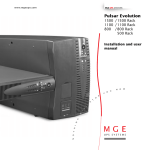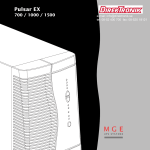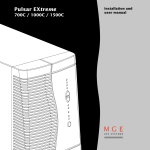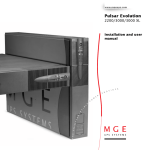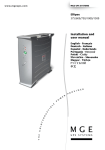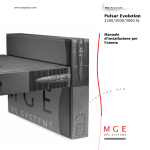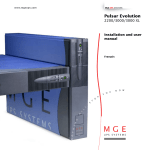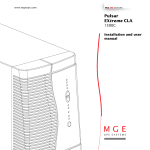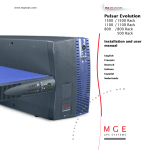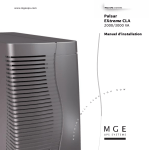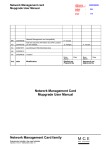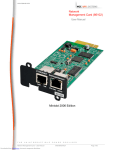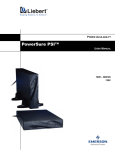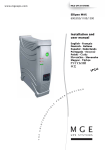Download Pulsar Evolution
Transcript
MGE_PulsarEvolution_1500_1100_800_500_iom_D403 www.mgeups.com MGE UPS SYSTEMS Pulsar Evolution 1500 / 1500 Rack 1100 / 1100 Rack 800 / 800 Rack 500 Rack Installation and user manual Y P O T N O T H I N G W I L L S O U N O W MGE UPS Systems 1660 Scenic Avenue Costa Mesa, CA 92626 (714) 557-1636 For service call 1-800-438-7373 www.mgeups.com Important Safety Instructions Read before installing product Thank you for selecting an MGE UPS SYSTEMS product to protect your electrical equipment. The Pulsar Evolution range has been designed with the utmost care. We recommend that you take the time to read this manual to take full advantage of the many features of your UPS. MGE UPS SYSTEMS pays great attention to the environmental impact of its products. Measures that have made Pulsar Evolution a reference in environmental protection include: ◗ The eco-design approach used in product development, ◗ recycling of Pulsar Evolution at the end of its service life. To discover the entire range of MGE UPS SYSTEMS products and the options available for the Pulsar Evolution range, we invite you to visit our web site at www.mgeups.com or contact your MGE UPS SYSTEMS representative. This manual contains important instructions for Pulsar Evolution Models that must be followed during installation, operation and maintenance of the UPS and batteries. The Pulsar Evolution UPS Models that are covered in this manual are listed below. Pulsar Evolution 500, 800, 1100, 1500 The normal battery voltage for all models is as follows: Pulsar Evolution 500-12V, 800-24V, 1100-24V, 1500-36V The Pulsar Evolution UPS is intended for installation in a temperature within 0 to 35º C (Pulsar Evolution from 500 to 1100 VA) or within 0 - 40º C for Pulsar Evolution 1500, free of conductive contaminants. This equipment has been tested and found to comply with the limits for a Class A digital device, pursuant to Part 15 of the FCC Rules. These limits are designed to provide reasonable protection against harmful interference when the equipment is operated in a commercial environment. This equipment generates, uses, and can radiate radio frequency energy and, if not installed and used in accordance with the instruction manual, may cause harmful interference to radio communications. Operation of this equipment in a residential area is likely to cause harmful interference in which case the user will be required to correct the interference at his own expense. Note Page 2 - 3400723200/AA Introduction Safety of persons ◗ The UPS has its own internal power source (the battery). Consequently, the power outlets may be energized even if the UPS is disconnected from the AC-power source. ◗ Dangerous voltage levels are present within the UPS. It should be opened exclusively by qualified service personnel. ◗ The UPS must be properly earthed. Measurements are required to ensure that the total leakage current of the UPS and the protected equipment does not exceed 3.5 mA by checking their characteristics (maximum leakage current of the UPS = 2 mA). ◗ The battery supplied with the UPS contains small amounts of toxic materials. To avoid accidents, the directives listed below must be observed: - Never burn the battery (risk of explosion). - Do not attempt to open the battery (the electrolyte is dangerous for the eyes and skin). - Comply with all applicable regulations for the disposal of the battery. - Batteries constitute a danger (electrical shock, burns). The short-circuit current may be very high. Precautions must be taken for all handling: remove watches, rings, bracelets and any other metal objects, use tools with insulated handles. Product safety ◗ ◗ ◗ ◗ ◗ ◗ ◗ ◗ ◗ The UPS connection instructions and operation described in the manual must be followed in the indicated order. UPS must be connected to a nearby wall outlet that is easily accessible. The UPS can be disconnected from the AC-power source by removing the power cord. Check that the indications on the rating plate correspond to your AC-power system and to the actual electrical consumption of all the equipment to be connected to the UPS. Never install the UPS near liquids or in an excessively damp environment. Never let a foreign body penetrate inside the UPS. Never block the ventilation grates of the UPS. Never expose the UPS to direct sunlight or source of heat. If the UPS must be stored prior to installation, storage must be in a dry place. The admissible storage temperature range is -25ºC to +55ºC. Special precautions ◗ ◗ ◗ All handling operations will require at least two people (unpacking, installation in rack system). Once installed and connected to the AC power source for the first time, the battery will start to charge. Full charging to obtain the rated battery backup time requires at least 8 hours. Before and after the installation, if the UPS remains de-energized for a long period, the UPS must be energized for a period of 24 hours, at least once every 6 months (for a normal storage temperature less than 25°C). This charges the battery, thus avoiding possible irreversible damage. During the replacement of the battery module, it is imperative to use the same type and number of element previously mounted in the UPS, in order to maintain an identical level of performance and safety. In case of doubt, don’t hesitate to contact our after sales department (for more information, refer to the web site www.mgeups.com). 3400723200/AA - Page 3 Foreword Using this document Information may be found in two ways, using: ◗ the contents; ◗ the index. Pictograms Important instructions that must always be followed. Information, advice, help. Visual indication. Action. Audio indication. In the illustrations on the following pages, the symbols below are used: LED off. LED on. LED flashing. Page 4 - 3400723200/AA Contents 1. Presentation 1.1 Overall view .................................................................................................................................. 7 Tower models ..................................................................................................................................7 Rack models ....................................................................................................................................7 2. 1.2 Back .............................................................................................................................................. 8 1.3 Control panel ..................................................................................................................................9 Installation 2.1 Unpacking and parts check ......................................................................................................10 Tower models ................................................................................................................................10 Rack models ..................................................................................................................................11 2.2 Installation ....................................................................................................................................12 Tower models ................................................................................................................................12 800/1100/1500 Rack models..........................................................................................................13 500 Rack model ............................................................................................................................14 3. 2.3 Connecting the protected equipment ........................................................................................15 2.4 Connection to the RS232 or USB communications port (optional) ........................................16 2.5 Connection to the data-line protection port (optional)..............................................................16 2.6 Installation of the communications-card option ......................................................................17 Operation 3.1 Start-up..........................................................................................................................................18 3.2 Shift to booster or fader mode (during voltage variations in the AC-input power) ....................18 3.3 Operation on battery power (following failure of AC-input power) ............................................19 Transfer to battery power ..............................................................................................................19 Threshold for the low-battery warning............................................................................................19 3.4 Personalisation (optional) ..........................................................................................................20 Function..........................................................................................................................................20 ON / OFF conditions tab ................................................................................................................20 Battery tab ......................................................................................................................................20 Voltage-thresholds tab ..................................................................................................................21 Sensitivity tab ................................................................................................................................21 3400723200/AA - Page 5 Contents 4. Maintenance 4.1 4.2 Trouble-shooting ..........................................................................................................................22 Replacement of the battery module ..........................................................................................23 Tower models ................................................................................................................................23 Rack models ..................................................................................................................................25 5. 6. Environment ....................................................................................................................................27 Appendices 6.1 Technical data Simplified diagram..........................................................................................................................28 Technical characteristics ................................................................................................................29 Examples of battery backup times ................................................................................................30 Page 6 - 3400723200/AA 6.2 Glossary ........................................................................................................................................31 6.3 Index ..............................................................................................................................................32 1. Presentation 1.1 Overall view Tower models Dimensions in inches (W x H x D) D Evolution 800 5.9 x 9.3 x 16.3 Evolution 1100 5.9 x 9.3 x 16.3 Evolution 1500 5.9 x 9.3 x 19 Weight in lbs H Evolution 800 23 Evolution 1100 25.4 Evolution 1500 XL 33 AR LS n P U lu ti o Ev o0 0 11 W Rack models Dimensions in inches (W x H x D) D Evolution 500 Rack 17.2 (19”) x 1.7 (1U) x 13.9 Evolution 1100 Rack 17.2 (19”) x 1.7 (1U) x 19.6 Evolution 1500 Rack 17.2 (19”) x 1.7 (1U) x 20.5 H Weight in lbs Evolution 500 Rack AR LS n P U ut io Ev ol Rack 1500 W 20 Evolution 800 Rack 34 Evolution 1100 Rack 35 Evolution 1500 Rack 42 3400723200/AA - Page 7 1. Presentation 1.2 Back Pulsar Evolution 800 / 1100 / 1500 Pulsar Evolution: 1 USB communications port. 2 RS232 communications port. 3 Data-line protection. 4 Slot for communications-card option. 5 Receptacle for direct connection of protected equipment. 6 Programmable receptacles (1 and 2). 7 Input circuit-breaker. 8 Connection to the utility. Vac OUT I max 12A 4 RS232 5 2 6 2 2 Programmable U.S. PAT. NO. 6,094,363 1 36Vdc, 9Ah Pb Reseau Mains Netz Volt 120V~1O Amps 12A MAX Hertz 50/60 Hz Util Load Ausg Volt 120V~1O Hertz 50/60 Hz W/VA 1000W/1440VA SITE WIRING FAULT 1 1 R 34Z5 U.P.S. 344-50254-00 T20A/125V~ Vac IN OUT IN Data line protection 8 7 3 Pulsar Evolution 500 / 800 / 1100 Rack 1 8 7 5 2 6 3 2 4 1 Pulsar Evolution 1500 Rack T20A/125V~ Programmable Vac OUT I max 12A 36Vdc, 9Ah 1 R Pb 34Z5 U.P.S. 3.7 U.S. PAT. No. 6,094,363 Vac IN AC Input Volt 120V~1O Amps 12A MAX Hertz 50/60 Hz AC Output Volt 120V~1O Hertz 50/60 Hz W/VA 1000W/1440VA RS232 SITE WIRING FAULT IN Data line protection OUT 344-50248-00 1 4 Page 8 - 3400723200/AA 8 7 2 1 3 5 2 6 2 1. Presentation 1.3 Control panel 10 Iluminated ON/OFF button for the receptacles. 11 Operation on battery power. 12 UPS fault. Battery fault. 1 13 14 15 16 2 Overload. Group 1 programmable receptacles supplied with power. Group 2 programmable receptacles supplied with power. Booster or fader mode. 17 Bargraph indicating percent load at output. % % 18 Bargraph indicating the battery charge level. 76 to 100%. 51 to 75%. 26 to 50%. 0 to 25%. 3400723200/AA - Page 9 2. Installation 2.1 Unpacking and parts check Tower models 20 23 21 22 24 AR LS n P U lu ti o Ev o0 0 11 21 RS232 communications cable for Windows Operating Systems. For Unix/Linux Operating Systems, please order for free the following part number: 66090 22 USB communications cable. 23 CD-ROM with the Solution-Pac and UPS Driver software. 24 Product documentation. Page 10 - 3400723200/AA 2. Installation Rack models 20 23 21 22 25 24 26 AR L S on P Uo l u t i ck Ra Ev 15 00 21 RS232 communications cable for Windows Operating Systems. For Unix/Linux Operating Systems, please order for free the following part number: 66090 22 USB communications cable. 23 CD-ROM with the Solution-Pac and UPS Driver software. 24 Product documentation. 25 Telescopic rails for mounting in 19" bay with mounting hardware. 26 Securing system for equipment power cords. 3400723200/AA - Page 11 2. Installation 2.2 Installation Tower models AR LS n P U lu ti o Ev o0 0 11 R An L St io P Uo lu0 E v1 0 1 Page 12 - 3400723200/AA 2. Installation 800/1100/1500 Rack models Follow steps 1 to 6 for rack mounting of the UPS on the rails. 2 1 6 2 2 4 3 2 5 SAR P U Lu t i o n E v o l Rack 1500 6 3 5 The rails and the necessary mounting hardware are supplied by MGE UPS SYSTEMS. 3400723200/AA - Page 13 2. Installation 500 Rack model Follow steps 1 to 3 for rack mounting of the UPS on the rails. 2 1 SAR P U Lu t i o n E v o l Rack 1500 3 1 3 Floor Mount Configuration Wall Mount Configuration AR L S ion P Uo l u t ck E v 00 Ra 15 AR L S ion P Uo l u t ck E v 00 Ra 15 Page 14 - 3400723200/AA 2. Installation 2.3 Connecting the protected equipment A Pulsar Evolution 1500 tower UPS has been used below to illustrate the instructions. The principle is the same for all the other tower and rack models. Check that the indications on the rating plate on the back of the UPS correspond to your AC-power system and to the actual electrical consumption of all the equipment to be connected to the UPS. 1 - Remove the power cord supplying the equipment to be protected. 2 - Connect the power cord to the AC-power wall receptacle 8 . Vac OUT I max 12A RS232 3 - Connect the protected equipment to the UPS using the cord 20 . Connect critical loads to the two standard receptacles 5 and any non-critical loads to the two programmable receptacles 6 (1 and 2). 5 2 2 1 Programmable U.S. PAT. NO. 6,094,363 6 36Vdc, 9Ah Pb Reseau Mains Netz Volt 120V~1O Amps 12A MAX Hertz 50/60 Hz Util Load Ausg Volt 120V~1O Hertz 50/60 Hz W/VA 1000W/1440VA SITE WIRING FAULT 1 R 34Z5 U.P.S. 344-50254-00 T20A/125V~ Vac IN OUT IN Data line protection 8 If the UPS is connected to a computer running MGE communications software, it is possible to program the interruption of power to the programmable receptacles 6 during operation on battery power, thus reserving backup power for the critical loads. 4 - Lock the connections using the securing system 26 (for rack models only). 20 As soon as the UPS is energised, the battery begins charging. Eight hours are required to charge to the full rated backup time. 3400723200/AA - Page 15 2. Installation A Pulsar Evolution 1500 tower UPS has been used below to illustrate the instructions. The principle is the same for all the other tower and rack models. 2.4 Connection to the RS232 or USB communications port (optional) 21 Vac OUT I max 12A RS232 1 - Connect the RS232 21 or USB 22 communications cable to the serial port or the USB port on the computer. 2 2 1 Programmable U.S. PAT. NO. 6,094,363 36Vdc, 9Ah Pb Reseau Mains Netz 1 Volt 120V~1O Hertz 50/60 Hz W/VA 1000W/1440VA SITE WIRING FAULT Util Load Ausg Volt 120V~1O Amps 12A MAX Hertz 50/60 Hz 22 R 34Z5 U.P.S. 344-50254-00 T20A/125V~ Vac IN OUT IN Data line protection The RS232 and USB communications ports cannot operate simultaneously. 2 - Connect the other end of the communications cable 21 or 22 to the RS232 2 or USB 1 communications port on the UPS. The UPS can now communicate with all MGE UPS SYSTEMS supervision, set-up or safety software. 2.5 Connection to the data-line protection port (optional) The data-line protection function on the UPS eliminates overvoltages flowing on the computer-network lines. Simply connect the line to be protected to the UPS using the data-line protection connectors (IN and OUT) as indicated opposite (RJ45 cables not supplied). RS232 Vac OUT I max 12A 2 Programmable U.S. PAT. NO. 6,094,363 36Vdc, 9Ah Pb Volt 120V~1O Amps 12A MAX Hertz 50/60 Hz Util Load Ausg Volt 120V~1O Hertz 50/60 Hz W/VA 1000W/1440VA SITE WIRING FAULT 1 Reseau Mains Netz 344-50254-00 T20A/125V~ Vac IN OUT Page 16 - 3400723200/AA IN Data line protection R 34Z5 U.P.S. 2. Installation 2.6 Installation of the communications-card option 1 - Remove the slot cover 4 secured by two screws. 4 2 - Insert the card in the slot. Vac OUT I max 12A 3 - Secure the card with the two screws. RS232 Restricted-access slot for the communications card 2 Programmable U.S. PAT. NO. 6,094,363 36Vdc, 9Ah Pb Reseau Mains Netz Volt 120V~1O Amps 12A MAX Hertz 50/60 Hz Util Load Ausg Volt 120V~1O Hertz 50/60 Hz W/VA 1000W/1440VA SITE WIRING FAULT 1 R 34Z5 U.P.S. 344-50254-00 T20A/125V~ Vac IN OUT IN Data line protection It is not necessary to shut down the UPS to install the communications card. This operation must be carried out by qualified personnel. 3400723200/AA - Page 17 3. Operation 3.1 Start-up 10 11 12 1 2 Press the ON / OFF button 10 . The buzzer beeps and all the LEDs come ON. The buzzer beeps twice during the self-test, then button 10 remains ON, indicating that the receptacles are supplied with power. - AC power is present: Only button 10 is ON. The protected equipment is supplied by the AC-power source. - AC power is absent: Button 10 and LED 11 are ON. The protected equipment is supplied by the UPS, operating on battery power. All the connected equipment is supplied with power. % % If button 10 or LED 11 are not ON or if LED 12 is ON, there is a fault (see section 4.1). Note: The battery is charged as soon as the UPS is connected to the AC-power source, even if button 10 is in the OFF position. 3.2 Shift to booster or fader mode (during voltage variations in the AC-input power) The booster and fader functions maintain the output voltage supplied by the UPS within close tolerances around the rated value even if significant voltage variations occur in the AC-input power. This avoids calling on battery power. The values defining the voltage range may be set using the UPS Driver software. During operation in booster or fader mode, LED 16 is ON, signalling a significant voltage variation in the AC-input power. 1 2 16 % % Page 18 - 3400723200/AA 3. Operation 3.3 Operation on battery power (following failure of AC-input power) Transfer to battery power The AC-input power is out of tolerances, LED 11 goes ON. During operation on battery power, the buzzer beeps every ten seconds. The equipment connected to the UPS is supplied by the battery. 11 1 2 % % Threshold for the low-battery warning When the threshold is reached, the buzzer beeps every three seconds. The low-battery warning threshold can be set by the user, with the “UPS Driver” software. 11 1 There is very little remaining battery backup time. Close all applications because UPS automatic shutdown is imminent. When the battery reaches the end of its backup time, the UPS shuts down and all the LEDs go OFF. 2 % % The equipment is no longer supplied with power. The UPS automatically restarts when power returns. If the UPS does not restart, check that the “automatic restart when power returns” function has not been disabled (see section 3.4 Personalisation). 3400723200/AA - Page 19 3. Operation 3.4 Personalisation (optional) Function Personalisation parameters can be set and modified using the UPS Driver software installed on a computer that is connected to the UPS (see section 2.4 Connection to the RS232 communications port). Check that the RS232 21 communications cable is connected. UPS Driver installation: 1 - Insert the Solution-Pac CD-ROM containing the UPS Driver software in the drive of a PC running Windows. 2 - Open the Windows File manager or Explorer and select the CD-ROM drive. 3 - Double-click "\Emb\Evolutio\Config\upsdriv.exe". Once UPS Driver has been installed, UPS parameters can be modified in a window containing a number of tabs, each presenting a set of parameters : ON / OFF conditions tab Configurable function Default setting Options Automatic restart Enabled Disabled Cold start Enabled Disabled Disabled Forced reboot Enabled Energy saving Disabled Enabled UPS ON / OFF via software Enabled Disabled Configurable function Default setting Options Once a week Every day Once a month No test Battery tab Interval between automatic battery tests Low-battery warning threshold Protection against deep discharges Page 20 - 3400723200/AA 20% of the remaining battery back- 10 to 40% of the remaining battery backup time up time Enabled Disabled 3. Operation Voltage-thresholds tab Configurable function Default setting Options Output voltage on battery power 120 V 100 - 127 V Upper threshold for transfer to battery power 153 V 141 to 153 V Fader-mode cut-in threshold 138 V 127 to 138 V 92 to 108 V Booster-mode cut-in threshold 92 V Lower threshold for transfer to battery power 80 V 80 to 94 V Maximum input-voltage range Disabled Enabled (1) Configurable function Default setting Options UPS sensitivity level Normal High or low (1) Lower threshold for transfer to battery mode = 70 V Sensitivity tab For more informations about these settings, refer to the Help function of the "UPS Driver" software. 3400723200/AA - Page 21 4. Maintenance 4.1 Trouble-shooting Troubleshooting not requiring MGE UPS SYSTEMS after-sales support (all versions) Indication Signification Correction LED 13 flashes and the buzzer beeps once. UPS overload. The power drawn by the connected equipment exceeds UPS capacity. Check the power drawn by the equipment and disconnect any non-priority devices. LED 12 flashes. A battery fault was detected during the automatic battery test. Replace the battery module (see section 4.2). Troubleshooting requiring MGE UPS SYSTEMS after-sales support Indication Signification LED 12 goes ON and UPS electronics have detected a UPS fault. the buzzer sounds contin- ◗ The connected equipment is no longer supplied. uously. The equipment connected to the UPS is no longer protected. Page 22 - 3400723200/AA Correction Call the after-sales support department. 4. Maintenance 4.2 Replacement of the battery module Tower models Safety rules Batteries constitute a danger (electrical shock, burns). The short-circuit current may be very high. Precautions must be taken for all handling: ◗ remove all watches, rings, bracelets and any other metal objects; ◗ use tools with insulated handles. Removal of the battery module This operation may be carried out with the UPS supplying power to the load. A - Unclip the small plate with the MGE logo on the front panel of the UPS. B - Remove the two screws. C - Remove the left-hand side of the front panel by pulling it slightly up and then forward. C AR LS n P U lu ti o Ev o0 0 11 B A D - Disconnect the battery module by pulling apart the connectors (never pull on the cables). D 3400723200/AA - Page 23 4. Maintenance E - Remove the battery module by pulling on the plastic tab and proceed with replacement. E Installation of the new battery module Carry out the above operation in reverse order. Caution: risk of electric arc when connecting the battery. To maintain an identical level of performance and safety, use a battery module identical to that previously mounted in the UPS. ◗ Press the two parts of the battery connector tightly together to ensure proper connection. ◗ ◗ Page 24 - 3400723200/AA 4. Maintenance Rack models Removal of the battery module This operation may be carried out with the UPS supplying power to the load. A - Unclip the small plate with the MGE logo on the front panel of the UPS. B - Remove the two screws. C - Remove the left-hand side of the front panel by pulling it forward. AR LS n P U ut iock ol Ra Ev00 15 C B A D - Disconnect the battery module by pulling apart the connectors (never pull on the cables). D 3400723200/AA - Page 25 4. Maintenance E - Remove the cover. E F - Remove the battery module by pulling on the plastic tab and proceed with replacement. F Installation of the new battery module Carry out the above operation in reverse order. Caution: risk of electric arc when connecting the battery. To maintain an identical level of performance and safety, use a battery module identical to that previously mounted in the UPS. ◗ Press the two parts of the battery connector tightly together to ensure proper connection. ◗ ◗ Page 26 - 3400723200/AA 5. Environment This product has been designed to respect the environment: It does not contain CFCs or HCFCs. UPS recycling at the end of service life: MGE UPS SYSTEMS undertakes to recycle, by certified companies and in compliance with all applicable regulations, all UPS products recovered at the end of their service life (contact your MGE branch office). Packing: UPS packing materials must be recycled in compliance with all applicable regulations. Warning: This product contains lead-acid batteries. Lead is a dangerous substance for the environment if it is not properly recycled by specialised companies. Web site: www.mgeups.com 3400723200/AA - Page 27 6. Appendices 6.1 Technical data Simplified diagram Filter Booster / fader transformer Input Output Inverter Charger Battery Page 28 - 3400723200/AA 6. Appendices Technical characteristics Pulsar Evolution Output rating AC-input power ◗ Voltage ◗ Frequency 500 800 / 800 rack 1100 / 1100 rack 1500 / 1500 rack 500 VA / 350 W 800 VA / 560 W 1100 VA / 700 W 1500 VA / 1000 W Single phase, 80 V to 153 V (1) 47 Hz to 70 Hz (50 Hz system) or 56.5 Hz to 70 Hz (2) (60 Hz system) Output power (operation on battery power) ◗ Voltage ◗ Frequency Battery (sealed lead-acid, maintenance free) ◗ Tower models ◗ Rack models Environment Noise level (operation on AC-input power) ◗ Operating temperature ◗ Relative humidity (without condensation) ◗ Single-phase, 120 V (3) (+ 6% / - 10%) 50/60 Hz +/- 1 Hz 2 x 6 V - 9 Ah, 2 x 12 V - 7.2 Ah, 4 x 6 V - 7.2 Ah 2 x 12 V - 9 Ah, 4 x 6 V - 9 Ah 3 x 12 V - 9 Ah, 6 x 6 V - 9 Ah <40 dBA <40 dBA 0 to 35° C 0 to 40° C 20 to 90% 20 to 90% (1) The upper and lower thresholds may be set using the UPS Driver software. (2) Or 40 Hz in low-sensitivity mode (may be set using the UPS Driver software). (3) Adjustable from 100 to 127 V using the UPS Driver software. 3400723200/AA - Page 29 6. Appendices Examples of battery backup times Pulsar Evolution 500 2 rack-optimized dense servers 1 router 1 hub 0 10 20 30 40 50 60 70 80 90 100 110 120 t (min) 0 10 20 30 40 50 60 70 80 90 100 110 120 t (min) 0 10 20 30 40 50 60 70 80 90 100 110 120 t (min) 0 10 20 30 40 50 60 70 80 90 100 110 120 t (min) Pulsar Evolution 800 3 rack-optimized dense servers 2 file/print servers 1 data server + 1 hub + 1 router 1 router 1 hub Pulsar Evolution 1100 3 rack-optimized dense servers 2 file/print servers 1 data server + 1 hub + 1 router 1 router 1 hub Pulsar Evolution 1500 5 rack-optimized dense servers 3 file/print servers 2 data servers + 1 hub + 1 router 1 router Page 30 - 3400723200/AA 6. Appendices 6.2 Glossary Backup time Time that the connected equipment can operate on battery power if AC-input power fails. Bargraph Device on the front panel indicating the percent remaining backup time or the percent load. Booster mode Automatic UPS operating mode whereby the input-power voltage is increased if it drops below a value set in the personalisation parameters, thus avoiding a battery discharge. De-energised The UPS must be physically disconnected from the AC-input power. Equipment Devices and systems connected to the UPS output. Fader mode Automatic UPS operating mode whereby the input-power voltage is decreased if it rises above a value set in the personalisation parameters, thus avoiding a battery discharge. Input circuit breaker Circuit breaker protecting the upstream distribution system against UPS faults. Personalisation The parameters for a number of UPS functions may be modified using the UPS Driver software to adapt UPS operation to user needs. Programmable receptacles Pulsar Evolution has two programmable receptacles. They may be used for sequential start-up of protected equipment, shedding of non-critical loads during operation on battery power or management of operating priorities to provide the most critical devices with more backup time before battery power runs out. These receptacles may be programmed using the Solution-Pac software on the CD-ROM supplied with the UPS. Receptacles Receptacle that allows you to connect the equipment you want to protect. RS232 communications port For UPS connection to a computer via the serial port. Solution-Pac MGE UPS SYSTEMS safety, set-up and supervision software suite on the CD-ROM supplied with the UPS. UPS Uninterruptible Power Supply. UPS Driver Communications software on the CD-ROM supplied with the UPS. It may be used to personalise the default settings. USB communications port For UPS connection to a computer via the USB port. 3400723200/AA - Page 31 6. Appendices 6.3 Index Booster mode ......................................................9, 18 Fader mode ........................................................9, 18 Sleep mode (automatic start) ..................................20 A Automatic start ................................................................20 B Bargraph............................................................................9 Battery Backup time ............................................................30 End of backup time..................................................19 Fault ..........................................................................9 Personalisation ........................................................20 Recycling ................................................................27 Replacement ..............................................22, 23, 24 Threshold for low-battery warning ..........................19 Transfer to battery power ....................................9, 19 Buttons ..............................................................................9 Buzzer ............................................................................19 O C S Circuit breakers Battery circuit breaker................................................8 Input circuit breaker ..................................................8 Communication Cards ..................................................................8, 17 Ports ....................................................................8, 16 Connections Data-line protection..................................................16 RS232 communications port ..................................16 USB communications port ......................................16 Safety..............................................................................23 Start-up ..........................................................................18 D W Dimensions........................................................................7 Web site ..........................................................................27 Weight ..............................................................................7 E Environment ....................................................................27 F Fault (UPS)........................................................................9 L LEDs..................................................................................9 M Mode Page 32 - 3400723200/AA Overloads ....................................................................9, 22 P Personnalisation ............................................................20 Battery ....................................................................20 ON / OFF conditions ..............................................20 Output......................................................................21 Ports RS232 ................................................................8, 16 USB ....................................................................8, 16 Programmable receptacles ..........................................8, 9 T Technical characteristics ................................................29 Temperature (excessive ambient) ..................................29 U UPS Driver....................................................18, 19, 20, 29 UPS ON / OFF via software ..........................................20
































